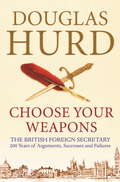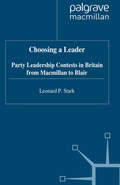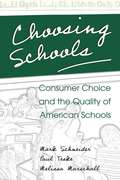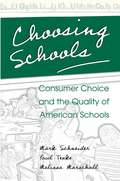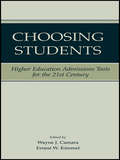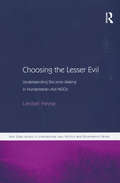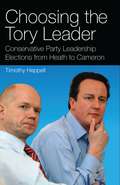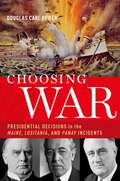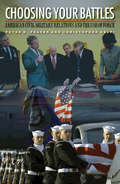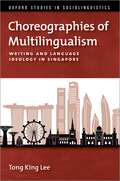- Table View
- List View
Choose Your Weapons: Two Centuries Of Conflict And Personalities
by Douglas HurdWhen writing his magnificent life of Robert Peel, Douglas Hurd found himself caught up again in a debate that has always fascinated him as a former diplomat and Foreign Secretary - the argument between the noisy popular liberal interventionist approach and the more conservative diplomatic approach concentrating on co-operation between other nations. The argument has run for two centuries - and is at the heart of heated discussion on both sides of the Atlantic today. Hurd concentrates on personalities and circumstances. He begins with the dramatic antagonism after Waterloo between Canning (liberal, populist, interventionist) and Castlereagh (institutions, compromise, real politics) - the last occasion on which ministerial colleagues fought a duel. A generation later comes Palmerston vs Aberdeen, from which Palmerston, the noisy interventionist, emerged the victor. A fascinating, but forgotten vignette is provided by the quarrel between Disraeli and his old friend and Foreign Secretary, Lord Derby, which led to Derby resigning as a protest against jingoism and Disraeli spreading the rumour that Lady Derby was leaking secrets to the Russian Ambassador. Salisbury and then Edward Grey wrestled with the same dilemma in the context of imperialism (Salisbury) and the European balance of power (Grey). Between the wars, another vignette describing Austen Chamberlain, the decent, monocled Foreign Secretary who began as an idealist (Locarno Treaty) and ended as a passionate opponent of appeasement. Finally Eden and Bevin, from wholly different backgrounds, combined with the Americans to create a post-war compromise, which served its purpose for half a century, but is coming apart today as the old questions resurface in new and savage forms in an era of terrorism and racial conflict.
Choosing a Leader: Party Leadership Contests in Britain from Macmillan to Blair
by L. StarkThis fascinating study contains important new information and original insights into a poorly-understood political phenomenon: contests for party leadership. It describes, in far greater detail than has appeared before, the frequently bitter struggles over leadership selection which have plagued the Conservative, Labour, Liberal, Social Democratic, and Liberal Democrat parties. Based on extensive interviewing with former party leaders, and careful analysis of leadership contests in each party, the book concludes that leadership selection rules rarely affect who stands for party leadership or who wins the contests.
Choosing a Prime Minister: The Transfer of Power in Britain
by Rodney BrazierWhen the door closes on one prime minister's rule, what happens next? General elections are only one possible way to enter 10 Downing Street. Using all relevant constitutional conventions, precedents, non-legal codes, historical events, and laws, this title offers a comprehensive account of all the circumstances in which the premiership is attained and lost. Over seven chapters, this book follows the sequence of events starting with how a prime minister can lose office, continues on to examine the procedures that then have to be followed, and considers at length the ways in which a politician can become leader of the country. Also explored are the possible emergencies, such as the sudden serious illness or even death of a prime minister, and their constitutional responses. This book concludes by looking at whether the procedures discussed could be set out in an authoritative and user-friendly code, and a sample one is suggested. Covering historical examples and modern turmoil, this book in an essential guide for understanding the rules and processes involved in choosing a prime minister.
Choosing a Prime Minister: The Transfer of Power in Britain
by Rodney BrazierWhen the door closes on one prime minister's rule, what happens next? General elections are only one possible way to enter 10 Downing Street. Using all relevant constitutional conventions, precedents, non-legal codes, historical events, and laws, this title offers a comprehensive account of all the circumstances in which the premiership is attained and lost. Over seven chapters, this book follows the sequence of events starting with how a prime minister can lose office, continues on to examine the procedures that then have to be followed, and considers at length the ways in which a politician can become leader of the country. Also explored are the possible emergencies, such as the sudden serious illness or even death of a prime minister, and their constitutional responses. This book concludes by looking at whether the procedures discussed could be set out in an authoritative and user-friendly code, and a sample one is suggested. Covering historical examples and modern turmoil, this book in an essential guide for understanding the rules and processes involved in choosing a prime minister.
Choosing an Identity: A General Model of Preference and Belief Formation
by Sun-Ki ChaiSocial science research is fragmented by the widely differing and seemingly contradictory approaches used by the different disciplines of the social sciences to explain human action. Attempts at integrating different social science approaches to explain action have often been frustrated by the difficulty of incorporating cultural assumptions into rational choice theories without robbing them of their generality or making them too vague for predictions. Another problem has been the major disagreements among cultural theorists regarding the ways in which culture affects preferences and beliefs. This book provides a general model of preference and belief formation, addressing the largest unresolved issue in rational choice theories of action. It attempts to play a bridging role between these approaches by augmenting and modifying the main ideas of the "rational choice" model to make it more compatible with empirical findings in other fields. The resulting model is used to analyze three major unresolved issues in the developing world: the sources of a government's economic ideology, the origins of ethnic group boundaries, and the relationship between modernization and violence. Addressing theoretical problems that cut across numerous disciplines, this work will be of interest to a diversity of theoretically-minded scholars. Sun-Ki Chai is Assistant Professor of Sociology, University of Arizona.
Choosing party leaders: Britain's Conservatives and Labour compared
by Andrew Denham Peter Dorey Andrew S. Roe-CrinesHow political parties choose their leaders, and why they choose the leaders they do, are questions of fundamental importance in contemporary parliamentary democracies. This book examines political leadership selection in the two dominant parties in recent British political history, exploring the criteria and skills needed by political leaders to be chosen by their parties. While the Conservative Party’s strong record in office owes much to its ability to project an image of leadership competence and governing credibility, the Labour Party has struggled with issues of economic management, leadership ability and ideological splits between various interpretations of socialism. The authors argue that the Conservatives tend towards a unifying figure who can lead the Party to victory, whereas the Labour Party typically choose a leader to unite the party behind ideological renewal. Exploring the contemporary political choices of leaders like Boris Johnson and Jeremy Corbyn, this book offers a timely insight into the leadership processes of Britain’s major political players.
Choosing party leaders: Britain's Conservatives and Labour compared
by Peter Dorey Andrew Denham Andrew S. Roe-CrinesHow political parties choose their leaders, and why they choose the leaders they do, are questions of fundamental importance in contemporary parliamentary democracies. This book examines political leadership selection in the two dominant parties in recent British political history, exploring the criteria and skills needed by political leaders to be chosen by their parties.While the Conservative Party’s strong record in office owes much to ability to project an image of leadership competence and governing credibility, the Labour Party has struggled with issues of economic management, leadership ability, and ideological splits between various interpretations of socialism. The authors argue that the Conservatives tend towards a unifying figure who can lead the Party to victory, whereas the Labour Party typically choose a leader to unite the party behind ideological renewal.Exploring the contemporary political choices of leaders like Boris Johnson and Jeremy Corbyn, this book offers a timely insight into the leadership processes of Britain’s major political players.
Choosing Presidents: Symbols of Political Leadership
by Michael NovakIn Choosing Presidents, Novak uses the election of an American president as a means to dissect the symbols of our national life and politics, exposing many as distorted perceptions of American realities. This work is a guide to the complexities of electoral politics and a lasting contribution to our understanding of the presidency.The author is Michael Novak.
Choosing Presidents: Symbols of Political Leadership
by Michael NovakIn Choosing Presidents, Novak uses the election of an American president as a means to dissect the symbols of our national life and politics, exposing many as distorted perceptions of American realities. This work is a guide to the complexities of electoral politics and a lasting contribution to our understanding of the presidency.The author is Michael Novak.
Choosing Schools: Consumer Choice and the Quality of American Schools (PDF)
by Mark Schneider Paul Teske Melissa MarschallSchool choice seeks to create a competitive arena in which public schools will attain academic excellence, encourage individual student performance, and achieve social balance. In debating the feasibility of this market approach to improving school systems, analysts have focused primarily on schools as suppliers of education, but an important question remains: Will parents be able to function as "smart consumers" on behalf of their children? Here a highly respected team of social scientists provides extensive empirical evidence on how parents currently do make these choices. Drawn from four different types of school districts in New York City and suburban New Jersey, their findings not only stress the importance of parental decision-making and involvement to school performance but also clarify the issues of school choice in ways that bring much-needed balance to the ongoing debate. The authors analyze what parents value in education, how much they know about schools, how well they can match what they say they want in schools with what their children get, how satisfied they are with their children's schools, and how their involvement in the schools is affected by the opportunity to choose. They discover, most notably, that low-income parents value education as much as, if not more than, high-income parents, but do not have access to the same quality of school information. This problem comes under sensitive, thorough scrutiny as do a host of other important topics, from school performance to segregation to children at risk of being left behind.
Choosing Schools: Consumer Choice and the Quality of American Schools
by Mark Schneider Paul Teske Melissa MarschallSchool choice seeks to create a competitive arena in which public schools will attain academic excellence, encourage individual student performance, and achieve social balance. In debating the feasibility of this market approach to improving school systems, analysts have focused primarily on schools as suppliers of education, but an important question remains: Will parents be able to function as "smart consumers" on behalf of their children? Here a highly respected team of social scientists provides extensive empirical evidence on how parents currently do make these choices. Drawn from four different types of school districts in New York City and suburban New Jersey, their findings not only stress the importance of parental decision-making and involvement to school performance but also clarify the issues of school choice in ways that bring much-needed balance to the ongoing debate. The authors analyze what parents value in education, how much they know about schools, how well they can match what they say they want in schools with what their children get, how satisfied they are with their children's schools, and how their involvement in the schools is affected by the opportunity to choose. They discover, most notably, that low-income parents value education as much as, if not more than, high-income parents, but do not have access to the same quality of school information. This problem comes under sensitive, thorough scrutiny as do a host of other important topics, from school performance to segregation to children at risk of being left behind.
Choosing Students: Higher Education Admissions Tools for the 21st Century
by Wayne J. Camara Ernest W. KimmelThis volume brings a variety of perspectives to bear on the issue of how higher education institutions can - or should - choose students during the early part of the 21st century. Many of the contributors report on research to develop and validate potential tools to assist those responsible for admission decisions. Other contributors, however, pose broader questions about the nature of selective admissions, about institutional responses to the changing demography of those seeking to enter higher education, or about the appropriate criteria of 'success' in higher education. The volume is particularly timely because the question of how changes in admission tools and processes will affect campus diversity following the recent Supreme Court decision concerning the University of Michigan. Diversity is an important concern of all of the contributors and the chapter by Lee Bollinger--President at Michigan at the time the court cases were filed--is particularly relevant. This book brings together the research that underlies a variety of proposed approaches to improving the selection of students. Providing support for the integrity of the admissions process and the validity of new tools to help a higher education institution to select a diverse student body, this book explores the implications of the assessment component of K-12 school reform for higher education admissions practices. The diverse contributions to this volume reflect the current ferment in educational research and educational practice as institutions of higher education seek to develop a new admissions paradigm for coming decades following the University of Michigan decisions. This book is intended for those leaders and professionals who set admission policies and practices in American colleges, and graduate and professional schools, as well as for those scholars and scientists who research, develop, and validate tools for use in the process of choosing students in ways that are congruent with an institution's mission, values, and goals.
Choosing Students: Higher Education Admissions Tools for the 21st Century
by Wayne Camara Ernest W. KimmelThis volume brings a variety of perspectives to bear on the issue of how higher education institutions can - or should - choose students during the early part of the 21st century. Many of the contributors report on research to develop and validate potential tools to assist those responsible for admission decisions. Other contributors, however, pose broader questions about the nature of selective admissions, about institutional responses to the changing demography of those seeking to enter higher education, or about the appropriate criteria of 'success' in higher education. The volume is particularly timely because the question of how changes in admission tools and processes will affect campus diversity following the recent Supreme Court decision concerning the University of Michigan. Diversity is an important concern of all of the contributors and the chapter by Lee Bollinger--President at Michigan at the time the court cases were filed--is particularly relevant. This book brings together the research that underlies a variety of proposed approaches to improving the selection of students. Providing support for the integrity of the admissions process and the validity of new tools to help a higher education institution to select a diverse student body, this book explores the implications of the assessment component of K-12 school reform for higher education admissions practices. The diverse contributions to this volume reflect the current ferment in educational research and educational practice as institutions of higher education seek to develop a new admissions paradigm for coming decades following the University of Michigan decisions. This book is intended for those leaders and professionals who set admission policies and practices in American colleges, and graduate and professional schools, as well as for those scholars and scientists who research, develop, and validate tools for use in the process of choosing students in ways that are congruent with an institution's mission, values, and goals.
Choosing the Future: Technology and Opportunity in Communities
by Karen Mossberger Caroline J. Tolbert Scott J. LaCombeDigital information drives participation in politics, the economy, and society. Yet great disparities exist as to which communities have access to the internet. In 2017, only half of residents of formerly industrial Flint, Michigan, had broadband or satellite internet at home, while over 90 percent of those in thriving Sunnyvale, California, in Silicon Valley, were connected. More recently, Covid-19 laid bare these persistent digital divides in both urban and rural communities, illustrating that broadband use is a fundamental resource for the future of opportunity in communities. While previous studies have examined the impacts of broadband infrastructure, they have indicated little about the extent to which local populations can afford and use the technology. Moreover, there has been limited scientific evidence on how broadband adoption matters for collective benefits. Including new data on broadband subscriptions from 2000-2017, and comprehensive analysis for U.S. states, counties, metros, cities, and neighborhoods, Choosing the Future argues that broadband use in the population is a form of digital human capital that benefits communities as well as individuals. Broadband has a causal impact across all types of communities--for economic prosperity, growth, income, employment, and policy innovation. Yet there are urban neighborhoods and rural counties where as little as one-quarter of the population has a broadband subscription, even when mobile is included. As we build "smart" cities and communities, as economies and jobs continue to experience rapid change, and as more information and services migrate online, it is communities with widespread broadband use that will be best positioned for inclusive innovation, with the digital human capital to thrive.
Choosing the Future: Technology and Opportunity in Communities
by Karen Mossberger Caroline J. Tolbert Scott J. LaCombeDigital information drives participation in politics, the economy, and society. Yet great disparities exist as to which communities have access to the internet. In 2017, only half of residents of formerly industrial Flint, Michigan, had broadband or satellite internet at home, while over 90 percent of those in thriving Sunnyvale, California, in Silicon Valley, were connected. More recently, Covid-19 laid bare these persistent digital divides in both urban and rural communities, illustrating that broadband use is a fundamental resource for the future of opportunity in communities. While previous studies have examined the impacts of broadband infrastructure, they have indicated little about the extent to which local populations can afford and use the technology. Moreover, there has been limited scientific evidence on how broadband adoption matters for collective benefits. Including new data on broadband subscriptions from 2000-2017, and comprehensive analysis for U.S. states, counties, metros, cities, and neighborhoods, Choosing the Future argues that broadband use in the population is a form of digital human capital that benefits communities as well as individuals. Broadband has a causal impact across all types of communities--for economic prosperity, growth, income, employment, and policy innovation. Yet there are urban neighborhoods and rural counties where as little as one-quarter of the population has a broadband subscription, even when mobile is included. As we build "smart" cities and communities, as economies and jobs continue to experience rapid change, and as more information and services migrate online, it is communities with widespread broadband use that will be best positioned for inclusive innovation, with the digital human capital to thrive.
Choosing the Labour Leader: Labour Party Leadership Elections from Wilson to Brown (International Library of Political Studies)
by Timothy HeppellThe means by which Labour Party leaders acquire their position determines their legitimacy and their authority over the parliamentary Labour Party and within the wider Labour movement. Understanding the rules governing Labour Party leadership selection and rejection, and the changing means by which respective leaders have been selected, is essential to an understanding of the development of Labour Party politics over the last fifty years. However, despite its centrality to the ideological, political and electoral identity of the Labour Party, the existing literature on Labour Party studies makes only limited reference to the means by which successive leaders actually acquired the party leadership.Drawing together debates on the method of party leadership selection and the ideological positioning of leadership candidates, this book considers the candidates and campaigning strategies for each of the eight party leadership elections from the election of Harold Wilson in 1963 to Gordon Brown in 2007. Within this the ideological influences of the shift in the method of selecting the Labour Party leader, from an elite parliamentary ballot to a mass participatory Electoral College, are considered. In charting the decline of the left, Timothy Heppell here considers how the outcome of democratisation has been the intensification of the security of tenure of the incumbent, and the reverse of their intended effect of making the party leader more accountable to the wider Labour movement. Given the bypassing of the Electoral College to anoint Gordon Brown in 2007, and the debates surrounding his authority and legitimacy as Labour Party leader thereafter, this book offers a comprehensive and timely examination of Labour Party leadership elections from Wilson to Brown.
Choosing the Leader: Leadership Elections in the U.S. House of Representatives
by Matthew N. Green Douglas B. HarrisThe first comprehensive study in more than forty years to explain congressional leadership selection How are congressional party leaders chosen? In the first comprehensive study since Robert Peabody’s classic Leadership in Congress, political scientists Matthew Green and Douglas Harris draw on newly collected data about U.S. House members who have sought leadership positions from the 1960s to the present—data including whip tallies, public and private vote commitments, interviews, and media accounts—to provide new insights into how the selection process truly works. Elections for congressional party leaders are conventionally seen as a function of either legislators’ ideological preferences or factors too idiosyncratic to permit systematic analysis. Analyzing six decades’ worth of information, Harris and Green find evidence for a new comprehensive model of vote choice in House leadership elections that incorporates both legislators’ goals and their connections with leadership candidates. This study will stand for years to come as the definitive treatment of a crucial aspect of American politics.
Choosing the Lesser Evil: Understanding Decision Making in Humanitarian Aid NGOs (Non-State Actors in International Law, Politics and Governance Series)
by Liesbet HeyseHow do non-governmental humanitarian aid organizations initiate, terminate and extend their project activities? Humanitarian aid organizations regularly face difficult decisions about life and death in a context of serious time constraints which force them daily to select whom to help and whom not to help. Liesbet Heyse focuses on how humanitarian aid organizations make these decisions and provides an inside view of the decision making processes. Two NGO case studies are used as illustration - Médecins sans Frontières (MSF) and Acting with Churches Together (ACT) - both of which operate in an international network and represent specific types of NGOs often found in the community. This book opens up the black box of NGO operations, provides an empirical account of organizational decision making and combines insights of organization theory and organizational decision making theory.
Choosing the Lesser Evil: Understanding Decision Making in Humanitarian Aid NGOs (Non-State Actors in International Law, Politics and Governance Series)
by Liesbet HeyseHow do non-governmental humanitarian aid organizations initiate, terminate and extend their project activities? Humanitarian aid organizations regularly face difficult decisions about life and death in a context of serious time constraints which force them daily to select whom to help and whom not to help. Liesbet Heyse focuses on how humanitarian aid organizations make these decisions and provides an inside view of the decision making processes. Two NGO case studies are used as illustration - Médecins sans Frontières (MSF) and Acting with Churches Together (ACT) - both of which operate in an international network and represent specific types of NGOs often found in the community. This book opens up the black box of NGO operations, provides an empirical account of organizational decision making and combines insights of organization theory and organizational decision making theory.
Choosing the Tory Leader: Conservative Party Leadership Elections from Heath to Cameron (International Library of Political Studies)
by Timothy HeppellThe means by which the Conservative Party have determined their party leadership has produced some of the most dramatic political theatre of the last four decades. The disputed succession to Harold Macmillan and the discrediting of the magic circle, the procedural changes designed to evict Edward Heath, the brutal political assassination of Margaret Thatcher, the bizarre resignation and immediate re-election of John Major, the putsch against Iain Duncan-Smith and the ritual acclamation of Michael Howard, only to have him replaced by the unexpected election of David Cameron have demonstrated the capacity of the Conservatives for political intrigue. In this new evaluation Timothy Heppell assesses the way in which the Conservative Party have determined their leadership since the 1960s. By considering the events that led to each leadership election, the candidates standing and their campaigning strategies, he explains how and why respective victors were elected. He argues the Conservatives have been maladroit when constructing their electoral procedures, they have returned unexpected party leaders, many of whom were to suffer from crises of legitimacy and accusations that they were default leaders. He observes how the dominance of ideology, as a destabilising influence on incumbents and a voting determinant in leadership elections, has been immensely disadvantageous to post-Thatcherite Conservatism. Rather than empowering incumbents to project their leadership credentials outwards to the electorate and against their Labour counterpart, successive post-Thatcherite Conservative party leaders have been forced to look inwards, devoting crucial time to the complexities of intra-party management and the threats against them from rivals from within the parliamentary party. Heppell concludes by asking whether the undisputed mandate and ideological pragmatism of David Cameron indicates that the Conservatives are learning from these mistakes in their own recent past.
Choosing War: Presidential Decisions in the Maine, Lusitania, and Panay Incidents
by Douglas Carl PeiferThroughout US history, presidents have had vastly different reactions to naval incidents. Though some incidents have been resolved diplomatically, others have escalated to outright war. What factors influence the outcome of a naval incident, especially when calls for retribution mingle with recommendations for restraint? Given the rise of long range anti-ship and anti-air missile systems, coupled with tensions in East Asia, the Persian Gulf, and the Black and Baltic Seas, the question is more relevant than ever for US naval diplomacy. In Choosing War, Douglas Carl Peifer compares the ways in which different presidential administrations have responded when American lives were lost at sea. He examines in depth three cases: the Maine incident (1898), which led to war in the short term; the Lusitania crisis (1915), which set the trajectory for intervention; and the Panay incident (1937), which was settled diplomatically. While evaluating Presidents William McKinley, Woodrow Wilson, and Franklin Delano Roosevelt's responses to these incidents, Peifer lucidly reflects on the options they had available and the policies they ultimately selected. The case studies illuminate how leadership, memory, and shifting domestic policy shape presidential decisions, providing significant insights into the connections between naval incidents, war, and their historical contexts. Rich in dramatic narrative and historical perspective, Choosing War offers an essential tool for confronting future naval crises.
Choosing War: Presidential Decisions in the Maine, Lusitania, and Panay Incidents
by Douglas Carl PeiferThroughout US history, presidents have had vastly different reactions to naval incidents. Though some incidents have been resolved diplomatically, others have escalated to outright war. What factors influence the outcome of a naval incident, especially when calls for retribution mingle with recommendations for restraint? Given the rise of long range anti-ship and anti-air missile systems, coupled with tensions in East Asia, the Persian Gulf, and the Black and Baltic Seas, the question is more relevant than ever for US naval diplomacy. In Choosing War, Douglas Carl Peifer compares the ways in which different presidential administrations have responded when American lives were lost at sea. He examines in depth three cases: the Maine incident (1898), which led to war in the short term; the Lusitania crisis (1915), which set the trajectory for intervention; and the Panay incident (1937), which was settled diplomatically. While evaluating Presidents William McKinley, Woodrow Wilson, and Franklin Delano Roosevelt's responses to these incidents, Peifer lucidly reflects on the options they had available and the policies they ultimately selected. The case studies illuminate how leadership, memory, and shifting domestic policy shape presidential decisions, providing significant insights into the connections between naval incidents, war, and their historical contexts. Rich in dramatic narrative and historical perspective, Choosing War offers an essential tool for confronting future naval crises.
Choosing Your Battles: American Civil-Military Relations and the Use of Force
by Peter D. Feaver Christopher GelpiAmerica's debate over whether and how to invade Iraq clustered into civilian versus military camps. Top military officials appeared reluctant to use force, the most hawkish voices in government were civilians who had not served in uniform, and everyone was worried that the American public would not tolerate casualties in war. This book shows that this civilian-military argument--which has characterized earlier debates over Bosnia, Somalia, and Kosovo--is typical, not exceptional. Indeed, the underlying pattern has shaped U.S. foreign policy at least since 1816. The new afterword by Peter Feaver and Christopher Gelpi traces these themes through the first two years of the current Iraq war, showing how civil-military debates and concerns about sensitivity to casualties continue to shape American foreign policy in profound ways.
Choosing Your Battles: American Civil-Military Relations and the Use of Force (PDF)
by Peter D. Feaver Christopher GelpiAmerica's debate over whether and how to invade Iraq clustered into civilian versus military camps. Top military officials appeared reluctant to use force, the most hawkish voices in government were civilians who had not served in uniform, and everyone was worried that the American public would not tolerate casualties in war. This book shows that this civilian-military argument--which has characterized earlier debates over Bosnia, Somalia, and Kosovo--is typical, not exceptional. Indeed, the underlying pattern has shaped U.S. foreign policy at least since 1816. The new afterword by Peter Feaver and Christopher Gelpi traces these themes through the first two years of the current Iraq war, showing how civil-military debates and concerns about sensitivity to casualties continue to shape American foreign policy in profound ways.
Choreographies of Multilingualism: Writing and Language Ideology in Singapore (OXFORD STUDIES SOCIOLINGUISTICS SERIES)
by Tong King LeeSingapore boasts a complex mix of languages and is therefore a rich site for the study of multilingualism and multilingual society. In particular, writing is a key medium in the production of the nation's multilingual order - one that is often used to organize language relations for public consumption. In Choreographies of Multilingualism, Tong King Lee examines the linguistic landscape of written language in Singapore - from street signage and advertisements, to institutional anthologies and text-based memorabilia, to language primers and social media-based poetry - to reveal the underpinning language ideologies and how those ideologies figure in political tensions. The book analyzes the competing official and grassroots narratives around multilingualism and takes a nuanced approach to discuss the marginalization, celebration, or appropriation of Singlish. Bringing together theoretical perspectives from sociolinguistics, multimodal semiotics, translation, and cultural studies, Lee demonstrates that multilingualism in Singapore is an emergent and evolving construct through which identities and ideologies are negotiated and articulated. Broad-ranging and cross-disciplinary, this book offers a significant contribution to our understanding of language in Singapore, and more broadly to our understanding of multilingualism and the sociolinguistics of writing.
